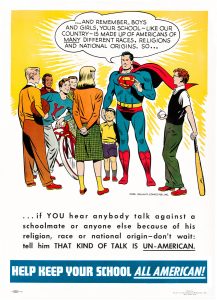Comics are just funny books for kids, right? That’s what Congress was told in the 1950’s. They were so convinced that comics were a kids medium that a whole system was put in place to protect those kids from subjects that might seem to lascivious and tantalizing, too obscure or terrifying, too inappropriate and vulgar. In other words, vampires, zombies, and werewolves (among other things) were banned, all under the thumb of the Comics Code Authority.
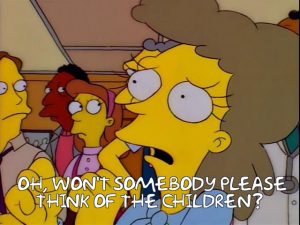
No, really, children were protected from the very real life menace knowing about of werewolves. Finally. Think of all the lycanthropic attacks they prevented by not believing in them. Close calls all.
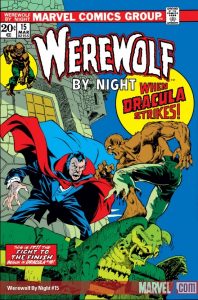
“Society’s real dangers face off.”
If you want to read more about the history of the Comics Code Authority, may I recommend Comic Code History: The Seal of Approval, posted at the website for the Comic Book Legal Defense Fund.
Well, time has passed and we can look back and laugh now. About some of it. That hasn’t changed the concern, the controversy, around certain comics both new and old. Some of these were in the era of the CCA, some are fairly modern, but they’re all books that have ruffled some feathers just by existing. If a little bit of controversy is too much for you, gentle reader turn away now, because we’re gonna touch on three appearances of the Ku Klux Klan in comics.
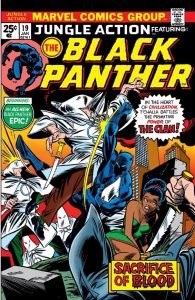
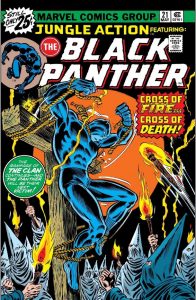
Superheroes have had run ins with the Klan for decades. Black Panther was tested in a title called ‘Jungle Action’ after his first appearances in the Fantastic Four. While his struggles now are global, there are three early appearances very much of their time from 1970s America. Jungle Action v2 #19-#21 brought T’Challa to Georgia where ‘the clan’ was very much a factor in his visit. Fun? Fact: Very much like Marvel’s use of ‘maggia’ instead of mafia, they also had ‘the clan’ instead of the Klan, but you didn’t have to be the most astute reader to know who was actually being talked about.
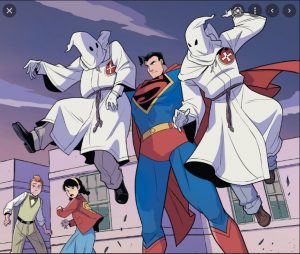
As strange as it may seem, Superman’s time fighting the KKK goes back all the way to the 1940’s. First serialized in a popular radio drama The Adventures of Superman in a 16-part series entitled “The Clan of The Fiery Cross”, the story had a resurgence with a less subtle title in 2019 with Gene Luen Yang’s Superman Smashes The KKK. The Eisner/Harvey award winner is a great middle school friendly book that manages to address a bevy of topics including economics, immigration (remember, Clark’s not from around here), and a certain group whose Name Would Actually Flag Zis and prevent it from being published. Let’s just say they really loved the idea of a Super Man until he was punching them in face and move on.
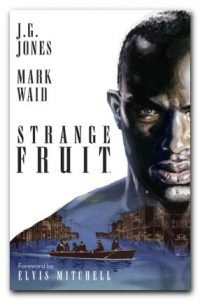
In 2015, Boom Studios published the excellent Strange Fruit. It’s the story of a strange visitor from another planet who arrives in Mississippi in 1927. He also appears to be black, alien or not. That goes over as poorly as you would imagine with much of the local populace. Klan from top to bottom, there are few who recognize that they’re on the brink of what was in 1927 the greatest natural disaster in American history. Using a real-life tragedy as the frame for their superhero story, writer Mark Waid (banned from DC then and maybe the biggest living Superman fan) and artist J.G. Jones (doing his first major sequential work since Wanted) bring this nightmare to life in coarse language and beautiful watercolors. It remains a great introduction to a real American tragedy, much like HBO’s Watchmen series did with the Tulsa race riot. (As always, the introduction comes before the actual story.)
These are not nearly all the appearances of these odious ghouls. Marvel’s Hate Monger origin could probably fill two of these. Wherever there are comics, there will be controversy. Wherever there is controversy, more than likely our heroes will be fighting the good fight. (I mean, Cap’s never going to join Hydra, right?) ((Wait, what’s Secret Empire?!?!?)).
I’ll leave you with an image from DC in the 1950s, and the words of Stan the Man himself, to speak clearly on why comics would address these topics. From a 1968 ‘Stan’s Soapbox’:
“Let’s lay it right on the line. Bigotry and racism are among the deadliest social ills plaguing the world today.
But, unlike a team of costumed super-villains, they can’t be halted with a punch in the snoot, or a zap from a ray gun. The only way to destroy them is to expose them — to reveal them for the insidious evils they really are. The bigot is an unreasoning hater — one who hates blindly, fanatically, indiscriminately. If his hang-up is black men, he hates ALL black men. If a redhead once offended him, he hates ALL redheads. If some foreigner beat him to a job, he’s down on ALL foreigners. He hates people he’s never seen — people he’s never known — with equal intensity — with equal venom.
Now, we’re not trying to say it’s unreasonable for one human being to bug another. But, although anyone has the right to dislike another individual, it’s totally irrational, patently insane to condemn an entire race — to despise an entire nation — to vilify an entire religion. Sooner or later, we must learn to judge each other on our own merits. Sooner or later, if man is ever to be worthy of his destiny, we must fill our hearts with tolerance. For then, and only then, will we be truly worthy of the concept that man was created in the image of God – a God who calls us ALL — His children.
“Pax et Justitia, Stan.”
